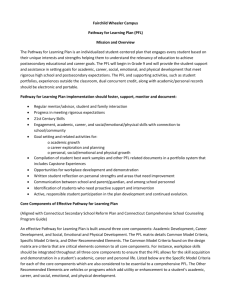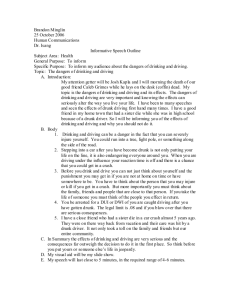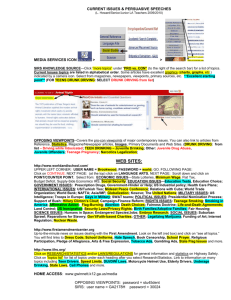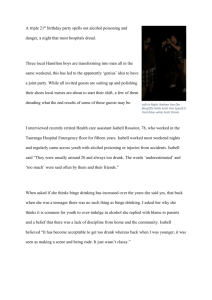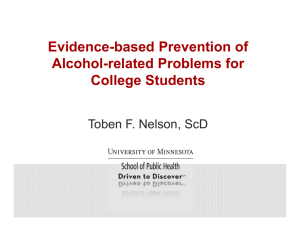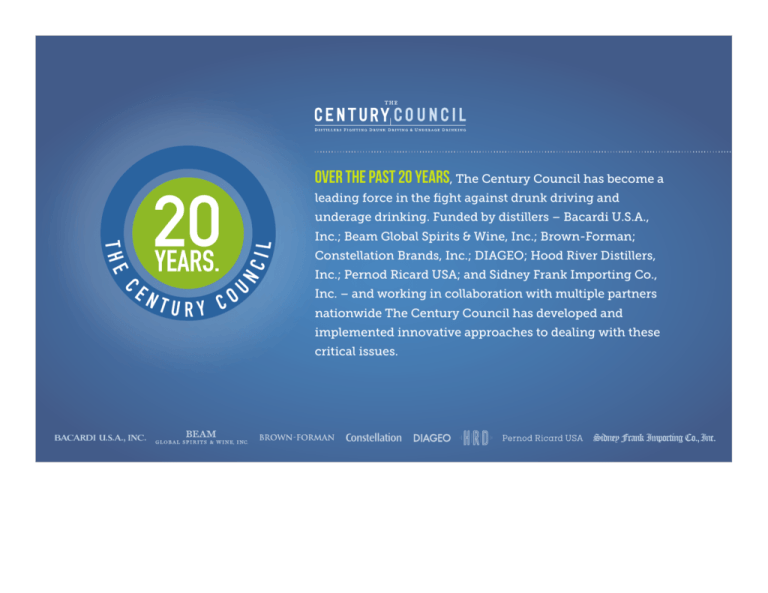
Over the past 20 years, The Century Council has become a
leading force in the fight against drunk driving and
underage drinking. Funded by distillers – Bacardi U.S.A.,
Inc.; Beam Global Spirits & Wine, Inc.; Brown-Forman;
Constellation Brands, Inc.; DIAGEO; Hood River Distillers,
Inc.; Pernod Ricard USA; and Sidney Frank Importing Co.,
Inc. – and working in collaboration with multiple partners
nationwide The Century Council has developed and
implemented innovative approaches to dealing with these
critical issues.
ALCOHOL-IMPAIRED DRIVING FATALITIES
In part and due to The Century Council’s work,
notable progress has been made. During the past two
decades, alcohol-impaired driving fatalities have
decreased 32 percent to a record low of 10,839.
During this same time, current underage alcohol
consumption decreased 33 percent to a historic low 27
percent since the inception of The Century Council.
The following retrospective provides a snapshot of
our contributions since our inception in 1991.
As we reflect on our accomplishments during the
past 20 years, we realize that more can be done to
improve the safety and health of our communities.
We look forward to continued progress in the fight
against drunk driving and underage drinking!
HAVE DECREASED
%
32 AND
UNDERAGE DRINKING HAS REACHED A
HISTORIC LOW OF
%
27
HELPING RETAILERS ON THE
FRONT LINES
SINCE ITS INCEPTION IN 1991,
The Century Council’s
commitment to assist retailers
has been demonstrated by the
development and distribution of
various initiatives especially
designed to deter young people
from attempting to purchase
beverage alcohol.
SEE THE CAMPAIGNS
SURVEYED
292
92
96
65
Early on, the “Front Lines” program offered retailers a broad
selection of fully tested eye catching materials to let youth know,
loud and clear, that if they were looking to buy alcohol they were in
the wrong place. Throughout the years multiple campaigns have
been developed to reinforce this message.
PERCENT WERE
DISPLAYING
MATERIALS
PERCENT RATED
THE MATERIALS
“VERY EFFECTIVE”
OR “SOMEWHAT
EFFECTIVE”
PERCENT FOUND IT
EASIER TO REFUSE TO SELL
ALCOHOL TO MINORS
The “Excuses” campaign – a collection of actual excuses used by
“wannabe” buyers was launched in 1997. A national survey of 292
retailers found that 92% were displaying these materials. Over 96%
rated the materials “very effective” or “somewhat effective” in
deterring underage attempts to purchase and about two-thirds (65%)
found the materials made it easier to refuse to sell alcohol to
underage youth. Over 6 million pieces of point-of-sale materials
have been distributed to over 100,000 retailers nationwide.
GO!
Learn more about
WE DON’T SERVE TEENS
“We Don’t Serve Teens” (2007), Don’t Even
Try” (1999), the “Pop-Culture” campaign
(2000), and “65%” (2004) are all examples of
successful research-based point-of-sale
initiatives.
d,
nor de eda
si eres me os estan allá.
c
los refres
fighting
Distillers
and
drunk driving
underage drinking
www.cen
turycouncil.org
Culturally sensitive adaptations of these materials
in Spanish have also been part of The Century
Council’s efforts to support retailers in areas with
high Latino populations.
From the original “Here’s Looking at You, Kid”
materials to the most recent “We Don’t Serve Teens”
campaign developed in collaboration with the U.S.
Federal Trade Commission – millions of pieces have
been distributed free of charge to hundreds of
thousands of retail outlets across the nation.
SI TOMA NO MANEJE
CULTURAL RELEVANCE THE KEY TO SUCCESS
Si Toma No Maneje was the first
comprehensive program in the
nation developed to provide the
Hispanic community with
culturally relevant information
to address drunk driving.
Initiated with a two-year seed grant from
California’s Office of Traffic Safety in 1989, Si
Toma No Maneje became a fully funded
program of The Century Council in 1992 and
was expanded to include underage
drinking-related messaging. California law
enforcement agencies credited the program
with contributing to a significant drop in DUI
arrests among California Hispanics and from
1991 to 1996, the rate of DUI arrests per 1,000
Hispanic driving population fell 39%.
The program’s multi-prong outreach effort included:
La Promesa, a designated driver pledge initiative
created in partnership with the Archdiocese of Los
Angeles that reached out to more than one million
Hispanics nationwide; Sin Rodeos: Hablando con
los Niños sobre el Alcohol, an adaptation of the
successful middle school program Ready or Not:
Talking with kids about alcohol; point of sale
materials in Spanish; and, a vast array of outdoor
(billboards), radio and television public awareness
campaigns. In 1994, The Century Council’s public
service announcement “El Niño” received an award
from Hispanic Business Magazine as Best Public
Service Announcement.
The Century Council’s commitment to providing the Hispanic community with culturally
sensitive information about drunk driving and underage drinking continues to be a priority.
In 2000, the ¡Vive, por nuestro futuro! ¡Si tomas, no manejes! campaign was developed in
partnership with Recording Artists, Actors and Athletes Against Drunk Driving (RADD) and the
National Association of Broadcasters (NAB).
KEEPING
CELEBRATIONS
SAFE!
Whether it’s Prom Season, Fourth of
July, Homecoming, Game Day or the
Holidays, celebrations should always
be a happy occasion. Throughout the
years, The Century Council has
worked with multiple partners in
communities across the nation to
increase public awareness of the
importance of responsible decision
making about beverage alcohol
when celebrating.
Campaigns such as La Promesa (1992), Key to Life (1994) and Before You
Celebrate, Designate (1996) were instrumental in educating community
members about the importance of the designated driver and responsible
hosting. The year-round sober rides program, Last Call (1993) and holiday
specific efforts such as Home Free (1993) set the foundation for our current
support of the Washington Regional Alcohol Program’s SoberRide.
To promote safety during Prom and Graduation season, The Century Council
developed the “Full House at Prom Night” program based on a mini television
episode featuring the cast of the hit ABC series, “Full House”. Launched in
1992, this educational program was distributed to over 8,000 high schools
reaching over 2 million students nationwide.
In recent years, a partnership with the American School Counselor
Association (ASCA) has provided an excellent distribution opportunity for
the Prom Night Tips for Parents poster and flyer.
In keeping with the times, new
communication tools have been used
to expand these important outreach
efforts including: blast e-mails, blog,
Twitter, & Facebook postings and a
series of interactive e-cards.
Prom
Video
E-card
CLICK TO WATCH!
The Snowman
Stumble
Holiday
Interactive
Game
CLICK TO PLAY!
The Fourth
of July
Interactive
Holiday
E-Card
CLICK TO VISIT!
CENTURY CITIES
WHAT DO THESE CITIES ALL
HAVE IN COMMON?
MAKING A DIFFERENCE ONE COMMUNITY AT A TIME
They were all part of a select
group of locations identified back
in 1993, by The Century Council,
PORTLAND, ME
to become “learning laboratories”
for a unique grassroots project
EUGENE, OR
LONG ISLAND, NY
OMAHA, NE
AMARILLO, TX
CHAMPAIGN/URBANA, IL
called Century Cities.
Serving as a catalyst, The Century Council
developed an effective process for creating
grassroots support to address drunk driving
and underage drinking in these communities.
Local coalitions introduced, tested and
perfected promising initiatives for possible
replication in other cities.
These coalitions developed initiatives supporting law enforcement,
education, public awareness and retailer involvement. One of the keys to the
success of this model was wide participation among community stakeholders
(private citizens, elected officials, law enforcement, educators, community
and faith based organizations, health care professionals, retailers, etc.).
THE CENTURY COUNCIL’S SUPPORT OF THESE MULTI-YEAR
PROJECTS INCLUDED THE FOLLOWING PHASES:
1
2
3
IDENTIFYING AND ORGANIZING
STAKEHOLDERS
PROVIDING AND IMPLEMENTING A VARIETY OF
PROGRAMS CUSTOMIZED TO EACH LOCATION
A Pacific Institute for Research and Evaluation (PIRE)
study of the Century Cities cited the following 5 primary
reasons for the Century Cities initiative’s success:
• Generated effective coalitions
• Had a clearly defined mission
• Provided effective organizational assistance
• Demonstrated ability to be replicated over several
locations
• Encouraged community empowerment
The Century Cities model of coalition
building and many programs developed
SETTING THE STAGE FOR SUSTAINABILITY
as part of this project are still being used
in communities across the country.
WITH KIDS
ABOUT ALCOHOL
In 1993, the Michigan Liquor Control
Commission and the Boys and Girls
Clubs of Southeast Michigan
approached The Century Council to
fund the development and testing of a
“reality-based” program to help adults
discuss alcohol with children at an
early age.
IT’S SOONER THAN YOU THINK!
Recognizing that it’s never too early to talk to kids
about the dangers of underage drinking and that
parents are the primary influence in children’s lives,
Ready or Not: Talking with kids about
alcohol became the first program of its kind to
reach out to parents of youth 10-14 years old. Its use
of real life scenarios and discussion groups provided
parents with the resources needed to have
meaningful conversations with their kids about the
dangers of underage drinking.
An independent survey by the Pacific Institute
As part of a national partnership with the Boys and Girls Clubs
Research and Evaluation (PIRE) among adults
of America, materials were distributed to all their clubs. In
addition, many other local, state and national organizations
who participated in the Michigan pilot program,
determined that two-thirds of participants were
motivated to talk with their kids about alcohol,
and two-thirds found the program helpful in
deciding what to say.
PERCENT
66
of participants were
motivated to talk to
their kids
received Ready or Not materials. To expand the program’s
reach, culturally sensitive Spanish and Native American
versions were developed in collaboration with education and
prevention experts from each one of these communities.
An Interactive game
that is part of the
Ask, Listen, Learn:
Kids and Alcohol
Don’t Mix campaign
CLICK TO VISIT!
Many years later, the main criteria that served as the
foundation for Ready or Not continues to be valid as
reflected by the development of the successful Ask Listen
Learn: Kids and alcohol don’t mix program.
As with all of our initiatives, the success of the Ask, Listen,
Learn: Kids and Alcohol Don’t Mix program is in part due
PARTNERS
to the support of a variety of partners. Since development,
the partnerships established through this initiative have
given the program the ability to reach millions of kids,
parents, and teachers across the nation.
“OH, YE S!”
OH NO SAYS
hy Lifestyle
. The most
nd TV dance champion
n,
an Olympic athlete—a
Apolo Anton Ohno is
probably heard the expressio
Olympian knows you’ve are what you drink, too.
decorated U.S. Winter
But remember: You
“You are what you eat.”
wrong stuff, like alcohol,
you feel good. Drink the
boxes to see
and
Healthy liquids make
picture
the
at
many ways. Look
and you’ll feel bad—in
of your body. This is especially
part
every
almost
how alcohol affects
talking about young bodies.
important when we’re
EfkXcck_\j\k_`e^j_Xgg\ekf
Ask,
Listen,
Learn
BRAIN
Kf8gfcfZ\ikX`eZ_f`Z\jXi\Zc\Xi%
Jfd\Z_XeZ\jXi\aljkefknfik_
kXb`e^%9X[Z_f`Z\j`eZi\Xj\
pfliZ_XeZ\jf]jl]]\i`e^YX[
Zfej\hl\eZ\j%
K_\k_i\\jkXid\jjX^\jY\cfn
Xi\\XZ_d`jj`e^Xnfi[%
Lj\\XZ_f]k_\k_i\\:jÇ
Z_f`Z\#Z_XeZ\j#Zfej\hl\eZ\jÇ
feZ\#kfÔcc`ek_\YcXebj%
MOUTH
8cZf_fcZXedXb\pfl
dldYc\pflinfi[j%Pfl
dXpjg\Xbkffcfl[cp%
PfldXpjXpil[\k_`e^j
k_Xkf]]\e[g\fgc\%Pfl
dXpjXpk_`e^jpflË[
e\m\ijXp`]pfl_X[eËk
[ilebXcZf_fc%Pfli
Yi\Xk_dXpjk`eb%
<P<J
8cZf_fcZXedXb\`k_Xi[kfjkXpXnXb\#
Ylkk_\e`kXcjf[`jkliYjpflijc\\g%N_\epflnXb\lg#
pfln`ccjk`ccY\k`i\[#Xe[dXpY\^iflZ_p#Xjn\cc%
Underage
drinking can
lead to bad
.
\m\ipfe\fi\XZ_k`d\#Ylkpfl
Student
Magazine
ZXeËkY\jli\n_`Z_fe\jn`cc_Xgg\e
kfpflfin_\e%?fnnflc[8gfcfËj
g\i]fidXeZ\Z_Xe^\`]_\[`[eËk
dXb\k_\i`^_kZ_f`Z\6
LUNGS
CXi^\Xdflekjf]XcZf_fcZXedXb\`k_Xi[]fipflkf
Yi\Xk_\%PflZXegXjjflk%@]pflk_ifnlg#pfldXpefk
Y\XYc\kfYi\Xk_\\Xj`cpXe[pfld`^_kZ_fb\%
The
only smart
LIVER
8cZf_fcZXeZXlj\]XkkfYl`c[lg`epflic`m\i%K_XkY\Zfd\jjZXik`jjl\#
n_`Z_ZXec\X[kfXc`m\i[`j\Xj\k_XkZflc[\m\eklXccpb`ccpfl%
is not to drink
alcohol when
you’re underage.
SMALL INTESTINES/PANCREAS
HEART
8cZf_fcZXe[XdX^\k_\c`e`e^f]pfli`ek\jk`e\j%
PfligXeZi\XjZXeY\Zfd\`ii`kXk\[%
8cZf_fcZXejki\jjpfli
_\Xik%PfldXp_Xm\Xe
`ii\^lcXi_\XikY\Xk#_`^_
Ycff[gi\jjli\#Xjkifb\
fi\m\e_\Xik]X`cli\%
Help kids say “YES” to a healthy lifestyle
and “NO” to underage drinking
STOMACH
BLOOD
8cZf_fcZXeX]]\ZkpfliYcff[ËjXY`c`kpkfZcfk%K_Xkd\Xej
`]pflXi\Zlk#`kn`ccY\_Xi[\ikfjkfgYc\\[`e^Xe[]fidX
jZXY%Pflin_`k\Ycff[Z\ccjÇk_\fe\jk_XkÔ^_k^\idjÇ
dXpefknfibXjn\cc#jfpfldXp^\kj`Zb%
Lolo Jones Finds
Balance On and Off
the Track
Apolo Anton Ohno’s
Healthy Habits
LEGS
8cZf_fcdXb\jpflZcldjp%PflZXeËknXcb
jkiX`^_kXe[pflki`g#\m\efm\iefk_`e^%
8cZf_fcZXe`ii`kXk\pflijkfdXZ_Xe[dXb\`kgif[lZ\
kffdlZ_XZ`[%Dfi\XZ`[`epflijkfdXZ_ZXeZXlj\
pflkfk_ifnlgfi]\\cj`ZbefnficXk\i%
Making a
Difference:
One Teen’s Fight
to Feed the Hungry
You Are What
You Drink
Any kid
who wants a bright future
doesn’t take
KIDNEYS
8cZf_fcZXedXb\pfl^fkfk_\
YXk_iffdfm\iXe[fm\iXe[fm\i%
PflY\Zfd\[\_p[iXk\[%
M`j`kXjbc`jk\ec\Xie%Zfd%
SCHOLASTIC and associated logos are trademarks and/or registered trademarks of Scholastic Inc. All rights reserved.
Photos, left to right: © FADI AL-ASSAAD Reuters/Corbis; © Christopher Morris/Corbis.
THE THREE C’S
;i`eb`e^XcZf_fcd`^_k[\gi\jjpflXe[X]]\Zkk_\YiX`eZ\ccjk_Xk_\cg
pflk_`ebXe[dfm\efidXccp%K_`jZflc[dXb\pfl[fXccjfikjf]
k_`e^jk_Xkpflnflc[eËkefidXccp[f%
Pfld`^_kefkY\XYc\kfi\d\dY\ipfliX[[i\jj%Pfld`^_kjkXikZip`e^]fief
i\Xjfe%Pfld`^_k^\kXÔ\iZ\_\X[XZ_\fi_Xm\X_Xi[k`d\ZfeZ\ekiXk`e^fe
n_Xkg\fgc\Xi\jXp`e^%Pfld`^_kY\Zfd\jf[`qqpk_XkpflXi\leXYc\kf[f
jlZ_YXj`Zk_`e^jXjk`\pflij_f\j%Pfld`^_kg`ZbXÔ^_kn`k_jfd\fe\dlZ_
Y`^^\ik_Xepfl%Pfld`^_kZfdd`kXZi`d\c`b\k_\]kfimXe[Xc`jd%Pfld`^_k
ileXZifjjX_`^_nXpfi[fjfd\k_`e^\cj\k_XkËj[Xe^\iflj%
to a Healt
TAKE A LOOK AT THIS PICTURE
OF APOLO TO SEE HOW
DRINKING MAY AFFECT YOU.
Federal Citizen Information
Center (FCIC)
8Jlggc\d\ekkfK@D<=FIB@;J
KXb\k_\
8jb#C`jk\e#
C\XieGc\[^\
JO IN TH E
,
n
Ask, Lisate
Le rn
Team
on alcohol.
N’ IT
KICKEI THER!
TOG
the
and off on
ant on Washingt
you
import
the
isions
ork is men from
y
the dec you. The om
Teamw
The wo
tand
earn.c
around
field. m unders
ryone t asklistenl le and
Freedoaffect eve
lifesty
to visi
make age kids a healthy
”
encour y ‘YES’ to drinking.
and “sa underage
‘NO’ to
erage
k und
a
you thin fit with
Why do g doesn’t
drinkin lifestyle?
p
healthy
e to kee t.
we hav at our bes
letes,
As ath to performchoices is lly
ecia
healthy ing smart
one, esp
But mak nt for any need to
we
make
importa believe
th to
kids. Weage our you the benefit
for
our
ns
enc
only way
decisio
good future. The good
ir
make
to say
of the
es, is
able to
to be ns at all tim king! ge drin
decisio
era
und
NO to
Q:
A:
Meet Pros Who No
Apolo Anton Ohno & Dara Torres
Live Healthy
Say “YES” to a healthy lifestyle and “NO” to underage drinking.
Join the team and take the pledge at asklistenlearn.com!
How to say YES to a
healthy lifestyle and NO
to underage drinking
© Sora DeVore
To read the rest of the interviews with Abby Wambach, Sarah Huffman, Becky Sauerbrunn, Jill Gilbeau, visit:
ASKLISTENLEARN.COM
A Public Service in Association with
asklistenlearn.com
FROM PERSONAL TRAGEDY TO EDUCATIONAL TRIUMPH
At the end of a long tiring day,
17-year-old Brandon Silveria had a few
drinks at a party. He managed to drive
his friends back to their homes but
then wrapped his car around a tree en
route to his own house. He spent
almost three months in a comma
followed by several years of rehab.
Brandon’s compelling story was first
featured in an episode of the television
show “Rescue: 911”.
In 1994, Brandon and his
father Tony agreed with The
Century Council that their
personal tragedy could
become an educational
opportunity to talk with high
school students about the
dangers of underage
drinking and drunk driving.
Over the next 15 years, they
would travel the country
sharing their story with high
school students and
encouraging them to make
safe and responsible
decisions about alcohol.
BRANDON SILVERIA VISITS SCHOOLS ACROSS THE NATION TO TALK ABOUT
THE DANGERS OF UNDERAGE DRINKING AND DRUNK DRIVING
DURING HIS COLLABORATION
WITH THE CENTURY COUNCIL,
Brandon’s personal presentations reached over two
million high school students nationwide. The video and
later DVD depicting his story was distributed to
thousands of schools and other organizations throughout
the nation.
Among its multiple recognitions, the “Brandon
Tells His Story” program won a first place
FREDDIE award in the American Medical
Association’s International Health and Medical
Film Competition.
2
MILLION
CLICK TO WATCH!
students reached
by personal
presentations
An Effective
Partnership
between Law
Enforcement
and Retailers
HOW DO YOU STOP YOUNGSTERS FROM TRYING TO
BUY ALCOHOL?
This has always been a major concern
for retailers and public safety officials yet
no effective strategies were available. In
1994, Cops in Shops® created a unique
partnership between retailers and law
enforcement to help stop illegal
underage alcohol sales and prevent
adults from buying alcohol for minors.
COPS IN SHOPS® places the focus on the perpetrators —
minors who try to purchase alcohol illegally and adults who
try to purchase and then provide alcohol illegally to minors.
1
SALT LAKE COUNTY, UT
SEVERAL COMPREHENSIVE IMPACT EVALUATIONS HAVE
BEEN CONDUCTED ON COPS IN SHOPS PROGRAMS.
The first evaluation, the National Highway Traffic Safety
Administration’s study “An Impact Evaluation of Underage
Drinking Prevention Projects”, examined four distinct communitybased underage drinking prevention projects, including The
Century Council’s Cops in Shops program in Salt Lake County,
UT. Of the four projects, Cops in Shops was the only one to show
an impact on alcohol-related crashes involving underage drivers.
2
WILSON COUNTY, NC
A second evaluation was conducted in Wilson County, North
Carolina. Pre- and post- test surveys showed a significant
reduction in the number of students who reported consuming
alcohol in the previous month and reported increased difficulty in
obtaining alcohol as compared to a control site in another
jurisdiction. Also, a program evaluation reported an increase in
students’ perception of the likelihood of being caught trying to
purchase and/or obtain alcohol was completed by The Century
Council in conjunction with the Pennsylvania Department of
Transportation and the Pennsylvania Liquor Control Board.
GO!
Learn more about
49
STATES
COPS IN SHOPS
have implemented
Cops in Shops
®
TO DATE, HUNDREDS OF POLICE
departments in 49 states and the
District of Columbia (from Santa Ana,
California to New Bedford,
Massachusetts) have implemented Cops
in Shops®. A number of states have
institutionalized this program concept
as their primary statewide enforcement
tool to reduce underage purchase of
alcoholic beverages. Additionally,
college and university police
departments have found the Cops in
Shops® program to be an effective tool
in their fight to stop underage drinking
in and around their campuses.
tcc on
Campus
For over 16 years, The Century Council has assisted
colleges and universities with innovative strategies
to promote alcohol education on campus. Its
commitment to developing a comprehensive
approach that includes research-based educational
materials for students, parents, faculty, administrators
and other members of the campus community while
supporting enforcement of the legal drinking age
provides a solid foundation to The Century Council’s
efforts to curb underage drinking and binge drinking
among college students.
Funded by a grant from The Century Council, Promising Practices: Campus
Alcohol Strategies was the first compilation of over 200 exemplary programs
addressing alcohol-related issues on America’s college campuses. Published in
1995, this resource was distributed to all of the approximate 3,800 four year
colleges and universities in the U.S.. As follow-on pieces the Promising
Practices Action Planner and its complementary Task Force Planner were
distributed in 2001.
Developed originally in 1997 by the University of Illinois at
Urbana-Champaign, the Alcohol 101 program in its
CD-ROM format was the first interactive tool designed to
promote responsible decision making about beverage alcohol
among college students. Since then, the program has been
updated twice Alcohol 101 Plus (2001) and Alcohol 101
Plus Online (2006). This successful program serve as the
foundation for Alcohol 101 for HS Seniors, developed in
collaboration with American School Counselor Association
and Speak Up!, a resource especially designed for student
athletes in partnership with NCAA.
The Century Council has also distributed millions of copies of its
Parents You’re Not Done Yet brochure to thousands of colleges
and universities for parents of their incoming freshmen. This
brochure has been also distributed to hundreds of high schools
nationwide for parents of seniors.
DOWNLOAD!
Most recently, what started as a sponsorship of the
American Advertising Federation’s National Student
Advertising Competition has become one of the core
elements of The Century Council’s new College Binge
Drinking Initiative. This comprehensive, multi-faceted
research effort is designed to gain a better
understanding of this issue from the perspective of
different members of the campus community
including students.
DOWNLOAD!
DEALING WITH
HARDCORE DRUNK DRIVING
A SMALL POPULATION WITH A TRAGIC IMPACT
In 1997, The Century Council
launched the National Hardcore
Drunk Driving Project to
develop programs that advocate
swift identification, certain
punishment, and effective
treatment for hardcore drunk
driving offenders.
National
Hardcore
Drunk
Driving
Project
OUT OF
7 10
Evidence shows that the hardcore drunk driver is responsible
for a disproportionate share of the alcohol-impaired traffic
fatalities each year. Hardcore drunk drivers are defined as
those who drive with a high BAC of 0.15 or above, who do so
DRIVERS
INVOLVED IN A FATAL ALCOHOL-IMPAIRED CRASH
HAD A BAC OF
%
0.15
OR HIGHER
repeatedly as demonstrated by having more than one drunk
driving arrest, and who are highly resistant to changing their
behavior despite previous sanctions, treatment or education.
Consistently about 70 percent of drivers involved in a fatal
alcohol-impaired crash had a BAC of 0.15 percent or higher.
In 1998, a series of community forums were held in
Massachusetts, Texas and Ohio that began a national dialogue
focusing on shared problems and creative solutions to
hardcore drunk driving. From the Grassroots to a
National Agenda reported to the nation the insights of
forum participants and presented the first comprehensive and
systematic approach to the problem. In addition, the project’s
Guide for Legislators, put concise information at the
fingertips of lawmakers and was widely distributed to elected
officials throughout the country.
Combined with these efforts, the highly acclaimed
documentary “Road Predators” which presented a
comprehensive look at the hardcore drunk driver was aired on
multiple PBS stations throughout the nation.
GO!
Learn more about
COMBATING HARDCORE DRUNK DRIVING
THE COMBATING HARDCORE DRUNK DRIVING SOURCEBOOK, now in its third edition, and the
Coalition to Fight Hardcore Drunk Driving comprised of representatives from the National
Transportation Safety Board (NTSB), the American Automobile Association (AAA), and the
National District Attorneys Association’s (NDAA) National Traffic Law Center, demonstrate The
Century Council’s continued commitment to providing resources to assist in the fight to
eliminate drunk driving.
WHAT’S
IN A
NUMBER?
Knowledge of drunk driving laws and how an
individual’s drinking affects their blood alcohol
concentration (BAC) is fundamental to making
responsible decisions about alcohol consumption.
In late 1999, The Century Council conducted a
national survey both in English and Spanish that
showed that most people – 70% were not aware of
the legal blood alcohol concentration in their state.
The survey also revealed that 81% of those polled
didn’t know how many standard drinks they could
consume in one hour and reach a BAC of .08.
GO!
In light of this information gap, The Century Council joined
forces with the University of Illinois at Urbana-Champaign to
develop the Blood Alcohol Educator (BAE). This first-of-its- kind
bilingual educational tool was designed to increase awareness
among Americans of their state’s Blood Alcohol Concentration
(BAC) law while at the same time, educating adults about how
drinking affects their individual BAC. Showcased as a virtual bar,
the algorithm developed to estimate individuals’ BAC included
variables such as gender, weight, time elapsed as well as the
number and type of drinks. Reviewed by National Institute on
Alcohol Abuse & Alcoholism (NIAAA) it was found to be
consistent with the latest research in the field.
Explore the
VIRTUAL BAR
“VIRTUAL BAR”
Blood Alcohol
Educator
increases BAC
law awareness
GO!
Learn more about
BLOOD ALCOHOL EDUCATOR
ORIGINALLY CREATED as a mini CD-ROM
and promoted via a mobile cyber café and
computer kiosks, the program has
continued to evolve throughout the years
to adapt with changes in technology and
the passage of the national .08 BAC limit
standard. The BAE program is now
available online at www.b4udrink.org and
most recently, a new version of this
successful program www.b4udrink.mobi
was developed to provide access to this
important information by users of
handheld devices.
THE BAE BLOOD ALCOHOL VAN
TRAVELED THE COUNTRY
Promoting Synergy within the Judicial System to
Fight Hardcore Drunk Drivers
In 2002, The Century Council and the National
Association of State Judicial Educators (NASJE)
convened a national panel to examine the
judiciary’s critical role in reducing hardcore drunk
driving. Building on the foundation established by
the National Hardcore Drunk Driver Project, that
judicial summit initiated an ambitious effort to
develop a judicial reference resource to help judges
more effectively adjudicate hardcore drunk driving
cases.
This effort lead to the publication of the Hardcore Drunk Driving
Judicial Guide: A Resource Outlining Judicial Challenges, Effective
Strategies and Model Programs. Over 4,000 copies of the guide were
distributed to judges nationwide and the material was presented to 3,600
judges in 36 states.
This initiative was recognized with the prestigious Peter K. O’Rourke Special
Achievement Award by the Governor’s Highway Safety Association, for its
achievements and contribution in the field of highway safety.
In recent years, the Judicial Education Program has been expanded to include
other professional areas within the system.
DOWNLOAD!
JUDGES
STATES
3600
36
The Hardcore Drunk Driving Prosecutorial
Guide: A Resource Outlining Prosecutorial
Challenges, Effective Strategies and Model
Programs was launched in the spring of 2009.
Developed for The Century Council by the
National District Attorney’s Association (NDAA),
this resource continues to be distributed to
district and prosecuting attorneys around the
country via the network of state Traffic Safety
Resource Prosecutors (TSRPs).
A year later, the American Probation and Parole Association
(APPA) spearheaded the development of the Hardcore Drunk
Driving Community Supervision Guide. This publication and its
companion online free training course are available to community
supervision and correctional professionals nationwide.
DOWNLOAD!
LEVERAGING PARENTS
AND FAMILY INFLUENCE
TO DETER UNDERAGE DRINKING
As a leader in the fight to reduce
underage drinking for two
decades, The Century Council
has been dedicated to developing
initiatives that are data-driven
and research-based. A 2003
survey among 10-18 year olds
commissioned by The Century
Council first identified family and
friends as the leading source of
Family and
friends are the
leading sources
of alcohol for
today’s youth
alcohol for today’s youth.
Combined with the additional
research identifying parents as
leading role models in their teens’
decision-making process
regarding drinking or not
drinking alcohol, The Century
Council quickly went into action.
concern and took steps to make parents and caregivers
aware of what today’s teens said, and to encourage and
motivate parents to step up, take action, and most
importantly talk to their sons Yand
daughters about the
o
Me u Co
ssa uld
ge Be
dangers of underage drinking. RegardHeld
Pa
re
nt/
Gu
ar
dia
n L
e
tte
r
Dea
r Pa
rent
/G
In
uard
sc
ian,
calle hool,
Und d Not your st
I ur erag in O udent
ur
e
ge
Hou athlet
info
you Drin
e
ki
prev rmatio to read ng an se: A is taki
N
frie ent yo n belo thro d Soc atio ng pa
ug
rt in
nw
nd
w,
id
harm s), an u, your whi h th ial H
e
ostin e In a new
ch
faci ful co d your child
can
g. itiativ prog
litat
nseq
As
fam (and help
ing
your e on ram
unde uences ily fro his/he
Did
child
Rep
■
rage as a m ve r
’s co
In
rodu
Nea You
ry
re
dr
addi
im
ach,
K
inki sult
cibl
m
tio
the rly ev now
of
ng.
e To
?
crim ediate n, le
er
la
ol
gi
peop w in yone
alco inal co ly susp slatio
know
Bu le un the U
n is
ho
en
nv
■
t yo
nite s th
der
pe
By l to an iction) d the
at
upho u m
d St
age
viol
dr ndin
it
yo
atin ne un of an iver’s g in
drin ld th ay no 21 to ates fo is agai
y ad
g th
licen som
t be
e
ns
dr
r
ki
de
la
yo
r
gove ng,
ult
w an
e la
e
aw ink al
ung t
so
who se (with states
w, 21.
are
co
you
to rnmen me st d to
that
know ou
alco
prev that to hol.
at
ar
ts
t
her
e an
e se
liabi hol
ar
en
ingl rega wou
lity by pa e limiti d lo t un
y fu rd to ld
dang friend nding
dera
rnish
law
ng cal
ssin
yo
erou s a m
ge
s.
g so yout
Soci
es
s co essa ur teen
h
cial
nseq ge th
Wha
serv al ho
an
ho access
st
uenc at ca d hi
t
st
■
who ing al ing is
n ha s or
Ta You
es.
co
ve
and ke tim Can
plac is un hol provid
D
to
der
ing
risks share e to lis o
prov e in a
the a yo
an
ten
asso your
■
drin iding party- min ung pe d/or
to
th
C
ci
im
and reate ated w ough your
no k. It alcoho like at um rson
ts
an
te
t on
ca
ag
m
l
not comm atm ith so abou enag
the n even to te osph e of
er
osph cial
t
21.
enag ere
alte accept unity
prem ex
host the le
As
ere
Soci
or
rnat
w
ab
ers
ing. gal
an
ises tend
by
■
ives le an here in yo
Adu
G
and/ to pa and th any al ho
ur
su
lt,
stin
■
law et info to un d offe ch be hom
ad
re
or
ei
Yo
So
s
r
did nts an r pe ult si g ca
unde cial ho u Cou
drin in yo rmed derage health havior e
er
mpl n ta
no
ur
ab
is
t pr d ho s for
ke
Adu rage st law ld B
to king pa area out drinki y
them y
ovid meo
e
yout
dr
st
ng
th
prov lts can inking s may Held
■
e th wne
h. rties an at re ate an .
to
If
ho
Li
id
be
e al rs w
d pr gulate d loca
It is
■
pare no su
held partie ld yo able
coho ho
Yo ing
ovid
ch
unde l
are
scho my re
prov u can alcoho civi s to ta u acco !
gove nts an
l.
law
ing
lly
spon
s
d
alco rage
and ol po
with iding also l to un or cr ke pl untabl
stat rnmen your exist
sib
hol
lic
be
,w
e so
co
dera imin ace on e fo
he
held all athl ies on ility as
un out ac the lo
cial t to im mm ork w
r al
dera
yo
tual catio ld civi ge gu ally
host
plem unity ith
team acco etes w unde your
■
ge
liabl ur pr lowin
othe
T
unta
law
ra
child
gues ly se n for lly or ests.
ent
ho
to
e fo oper g
team . Alc
fin he pe
s.
brea ge al
and lobb r
th
cr
ts. rving
’s
ty
r se
oh ble,
es
na
co
enfo y
or e unde iminal
rvin .
spor . Also ol in regard k the hol coach
goes , and lties
prov
us
rce
ly
ci
to
g or
ra
alon civil for br
tend ts seas , as ad dent less of law an e will advi
idin ge dr liabl
g w lawsu eaki
s
ul
on
e
g al
in
ith
and s to flo s an ts, w may their d our be st se you
ng
coho king for sim
ric
le
them its—as thes
ta
sc
e
d
th
be
ad
hool tly
ply
at
l to part
aw urish, school must
to lent
.
wel e law
are
the y
have auto s and ’s ru upheld our
l as
s
I en
of th such as -relat
the are po
a he matic posit les will . Any
e in
ho ed
publ ssib
illeg courag
crea mec events ighten ejectio ion on be
ic hu le ja
om
sed
will al unde e you
whe ed
mili il tim
aw n from their
to
risks ing,
n
aren
wor
thei be pr rage
e,
atio
th
thes prom unde
dr
k
r fu otec
n th
e ev , an rage ess du e
ture ted inking with
at
rin
dr
ents d gr
us
from
s.
in
Sinc
to
may adua inking g
prev
harm our
erel
tion,
co
br
en
y yo
m
ing
ing.
urs,
them mun t social
____
ho
selv ity, so
(Coa ____
es an that sting
____
ch)
an
d ot
yo
____
hers ung d
, as peop
____
le
wel
____
l as
____
____
____
____
____
____
__
Ph
oto
:©
An
de
rse
n Ro
ss/P
ho
tod
isc
/G
ett
y Im
ag
es
.
©
SW
Pro
du
cti
on
s/P
ho
tod
isc
/G
ett
y Im
ag
es
.
ing Liab
Un le:
der An
age Im
Dri port
nki ant
ng
8
No
t in
AN
a
Ath tionw
leti
id
c D e In
it
ire
cto iative
of drinking teens get alcohol
Ou
rH
ous
e
rs/C
o
oac n Un
hes dera
g
Gu
ide e Drin
k
ing
an
dS
ocia
l
PERCENT
65
THE CENTURY COUNCIL believed there was cause for
Ho
stin
g
from friends and family
This very revealing research was the foundation for the 65% point of sale campaign, a national
initiative, to get the message out about where teens get alcohol– 65% said family and friends – and
where they didn’t – only 7% of youth cited retailers who fail to check identification. It was also the
foundation for the national We Don’t Serve Teens initiative originally developed in collaboration
with the U.S. Federal Trade Commission (FTC) and Not In Our House: A Nationwide Initiative on
Underage Drinking and Social Hosting developed in collaboration with the International Institute
for Alcohol Awareness (IIAA).
THE CENTURY COUNCIL has made notable strides
in the fight against drunk driving and underage drinking,
but we would not have been able make as great an impact
without the contributions and expertise of others. Our
success is attributed to our dedication to our mission
and also through the experience and diverse viewpoints
established by The Century Council’s distinguished
National Advisory Board.
• Honorable Susan Molinari, Chairman, The Century Council and former Member of Congress
• Ralph S. Blackman, President and CEO, The Century Council
CURRENT NATIONAL ADVISORY BOARD MEMBERS:
• Thurbert Baker, Partner, McKenna, Long & Aldridge and former Georgia Attorney General
• Michael R. Fields, J.D., Judge, Harris Cunty Criminal Court #14
• Carley Graham Garcia, Global Industry Relations, Google, Inc.
• Patrick J. Stapleton, III, Chairman, National Alcohol Beverage Control Association (NABCA)
• Lisa Graham Keegan, The Keegan Company
• Robert L. King, J.D., President, Kentucky Council on Postsecondary Education
• Colonel Lonnie J. Westphal, Former Vice President of IACP Chief (Ret.) Colorado State Patrol
• Anthony E. Wolf, Ph. D., Clinical Psychologist and Best-selling Author
NATIONAL ADVISORY BOARD MEMBERS WHO HAVE COMPLETED THEIR TERMS OF SERVICE INCLUDE:
• The Honorable Bruce Babbitt, former US Secretary of the Interior
• The Honorable Arnold I. Burns, Esq., former Deputy Attorney General of the US
• Rev. Patrick J. Calahan, S.J., Associate Chancellor, Loyola Marymount University
• The Honorable William T. Coleman, Jr., former Secretary of Transportation
• The Honorable Peter H. Dailey, former US Ambassador to Ireland
• The Honorable John A. Gavin, former US Ambassador to Mexico; served as The Century Council's founding Chairman
and Chief Executive Officer from 1991 until 1994
• Honorable Heidi Heitkamp, Former North Dakota Attorney General
• Thomas B. Adams, former Chairman, American Association of Advertising Agencies
• J. Clayburn LaForce, Jr., Ph.D., former Dean, John E. Anderson Graduate School of Management, UCLA
• The Honorable John C. Lawn, former Administrator, US Drug Enforcement Administration
• The Honorable Ann Dore McLaughlin, former US Secretary of Labor
• John J. Ring, MD, former President, American Medical Association
• The Honorable Togo West, former Secretary of Veteran's Affairs and former Secretary of the Army
• Dave Winfield, founder of the Winfield Foundation for Youth and former Major League Baseball star
• Patrick B. Harr, M.D., Former Chairman of the Board, American Academy of Family Physicians

